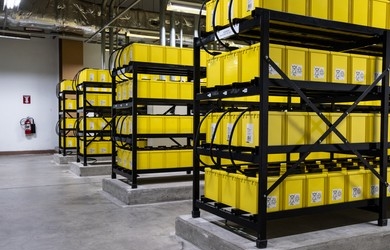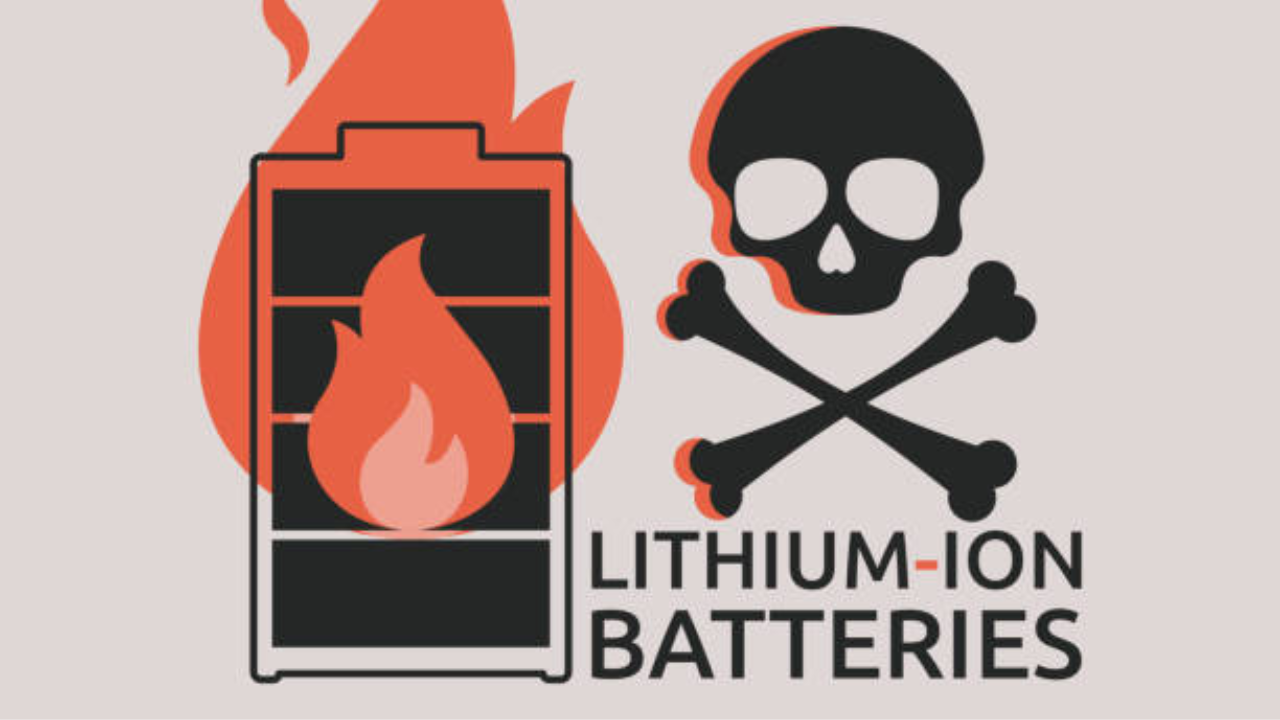Are lithium batteries safe? They can pose risks if mishandled or exposed to certain conditions. Lithium batteries have become increasingly popular due to their high energy density and long lifespan.
However, concerns about their safety have also arisen. While lithium batteries are generally safe, mishandling or exposure to extreme conditions can pose risks. For example, if a lithium battery is punctured or damaged, it can cause a short circuit and potentially result in a fire or explosion.
Similarly, exposing lithium batteries to high temperatures can also lead to thermal runaway, combustion, or the release of toxic gases. To ensure the safe use of lithium batteries, it is essential to handle and store them properly, avoid extreme conditions, and dispose of them responsibly.
The Basics Of Lithium Batteries
When it comes to the basics of lithium batteries, it’s essential to understand their structure and function. From what precisely a lithium battery is to how it operates, delving into these fundamental aspects can provide crucial insights into the safety and reliability of these power sources.
What Is A Lithium Battery?
A lithium battery is a type of rechargeable battery that utilizes lithium ions as the primary component, enabling the storage and release of electrical energy. It is known for its high energy density, which makes it ideal for various portable electronic devices.
How Do Lithium Batteries Work?
Lithium batteries operate by moving lithium ions between the positive and negative electrodes. The ions move from the positive to the negative electrode when the battery is charged. During discharge, they return to the positive electrode, generating electrical energy.
Common Safety Concerns
Lithium batteries raise common safety concerns due to their potential for overheating and igniting. Handling and storing these batteries properly is crucial to minimize the risk of accidents and ensure personal safety.
Fire And Explosion Risks
Lithium batteries have gained widespread popularity due to their high energy density and long lifespan. However, one common safety concern of lithium batteries is their potential for fire and explosion risks. Flammable electrolytes and combustible materials within the battery make it susceptible to thermal runaway and subsequent combustion, leading to fire incidents.
Factors such as manufacturing defects, physical damage, improper charging or discharging, or exposure to high temperatures can trigger thermal runaway, which is a rapid increase in temperature within the battery. When this occurs, it can cause the battery to rupture, release toxic gases, and even explode, posing a significant safety hazard to users.
Thermal Runaway
Thermal runaway is a self-perpetuating reaction within a lithium battery that can result in rapid heating, explosion, and fire. It typically occurs due to excessive heat generated during regular operation or external factors such as overcharging, short circuits, or mechanical abuse.
If the temperature inside the lithium battery rises uncontrollably due to thermal runaway, it can initiate an exothermic reaction, causing the battery to release flammable gases. This release of gases creates a feedback loop, further increasing the temperature and accelerating the reaction until thermal runaway progresses to the point of an explosion or combustion.
Overcharging And Overheating
Overcharging and overheating are additional safety concerns associated with lithium batteries. When a lithium battery is overcharged, excessive current flows through the battery, forming metallic lithium. This metallic lithium can cause internal short circuits within the battery, potentially causing it to overheat, ignite, or even explode.
Furthermore, exposure to high temperatures, whether through external heat sources or an environment with high ambient temperatures, can also contribute to overheating lithium batteries. When a lithium battery is subjected to elevated temperatures, it can experience degradation, reduced performance, and an increased risk of thermal runaway.

Regulations And Safety Measures
Lithium batteries are generally safe when handled and transported, following proper regulations and safety measures. Manufacturers and distributors comply with strict guidelines to minimize the risk of fire or explosion, ensuring the safety of lithium batteries in various applications. Regular inspections and adherence to safety protocols are crucial for safe use and handling.
International Regulations
Lithium batteries play a crucial role in our daily lives, powering our smartphones, laptops, and other electronic devices. However, ensuring the safety of these batteries is of paramount importance. International regulations have been implemented to prevent accidents and promote safe usage.
Transportation Safety Guidelines
Transporting lithium batteries requires strict adherence to safety guidelines. Different modes of transportation have specific regulations to ensure the safe transit of these batteries.
For example, the International Air Transport Association (IATA) has set rules for air transportation, while the International Maritime Organization (IMO) governs the safety measures for the maritime industry.
Manufacturers’ Safety Standards
Manufacturers of lithium batteries also have their safety standards to ensure the reliability and safety of their products. These standards cover various aspects, such as design, production, testing, and labeling. By following these standards, manufacturers can minimize the risk of accidents and maintain the quality of their batteries.
To meet these safety standards, lithium battery manufacturers employ various measures. These may include robust quality control processes, rigorous testing procedures, and compliance with international certifications. Additionally, they may design batteries with protective features like built-in circuitry to prevent overcharging or overheating.
Adhering to these manufacturers’ safety standards is crucial for the safe use of lithium batteries and consumer confidence. When purchasing a lithium battery, choosing products from reputable manufacturers who prioritize safety and adhere to these industry standards is essential.
In conclusion, strict regulations and safety measures govern lithium batteries’ production, transportation, and use. International regulations, transportation safety guidelines, and manufacturers’ safety standards all contribute to ensuring the safety and reliability of these essential power sources.
By understanding and following these regulations and standards, users can enjoy the benefits of lithium batteries while minimizing the risk of accidents or malfunctions.
Case Studies Of Lithium Battery Incidents
Lithium batteries have gained popularity for their high energy density and long-lasting power. However, there have been instances of lithium battery incidents that have raised concerns about their safety.
Famous Incidents Involving Lithium Batteries
1. Samsung Galaxy Note 7: This infamous case involved numerous reports of the smartphone’s lithium-ion battery overheating and, in some instances, catching fire. The subsequent product recall and discontinuation highlighted the potential dangers of lithium batteries.
2. Boeing 787 Dreamliner: The aircraft faced multiple incidents related to lithium battery malfunctions, grounding the entire fleet for investigation and subsequent safety modifications.
3. Tesla Model S: Several incidents of lithium battery fires in Tesla’s electric vehicles have prompted safety inquiries and improved battery design and thermal management.
Lessons Learned From Past Accidents
1. Proper quality control and testing procedures are essential to identify and mitigate potential risks associated with lithium batteries.
2. Effective thermal management systems prevent overheating and thermal runaway in lithium battery applications.
3. Transparency and prompt response to lithium battery incidents are vital to maintaining consumer trust and product safety.
Future Developments In Lithium Battery Safety
As technology and innovation continue to advance at an unprecedented pace, so does our quest for safer and more efficient lithium batteries. Recognizing the importance of battery safety, researchers and manufacturers are actively investing in developing advancements that will improve the performance of these batteries and enhance their safety features.
This article will explore future developments in lithium battery safety and how they are crucial in ensuring our devices’ overall safety and reliability.
Advancements In Battery Technology
The future of lithium battery safety lies in advancements in battery technology. Manufacturers are constantly exploring ways to enhance the design and construction of these batteries to minimize the risk of accidents. These advancements aim to improve the quality and stability of lithium-ion cells, making them less susceptible to issues such as thermal runaway and explosion.
One such development is using solid-state batteries, replacing the liquid electrolyte in traditional lithium-ion batteries with a solid-state alternative. Solid-state batteries have the potential to offer higher energy density, faster charging times, and increased safety due to their reduced risk of thermal runaway.
Researchers are tirelessly working to overcome the current limitations of solid-state batteries and bring them closer to commercial viability.
Another area of focus is the development of alternative materials for battery components. Researchers are exploring materials that are less reactive and more stable, reducing the likelihood of overheating and battery failure.
By replacing the commonly used graphite anode with materials such as silicon or lithium metal, batteries can potentially store more energy while maintaining a high level of safety.
Improving Safety Features And Materials
Beyond advancements in battery technology, improving safety features and materials is another crucial aspect of enhancing lithium battery safety. Manufacturers are investing in developing better protection systems, such as advanced battery management systems (BMS) and safety circuits that can detect and prevent potential hazards.
These systems monitor temperature, voltage, and current flow, ensuring the battery operates within safe limits and minimizing the risk of overheating or electrical faults.
The addition of flame-retardant materials and improved casing designs also make lithium batteries safer. Flame-retardant additives can prevent or slow fire spread in case of a thermal runaway event, while enhanced casing designs provide better protection and thermal insulation.
Furthermore, research is being conducted to optimize battery charging algorithms and develop intelligent battery management systems that tailor the charging process to the specific battery’s needs. This ensures that batteries are charged efficiently, reducing the chances of overcharging or undercharging, which can negatively impact battery safety and lifespan.
All these efforts aim to enhance the overall safety of lithium batteries, providing consumers with peace of mind and promoting their widespread adoption in various industries.

Can lithium batteries catch fire when not in use?
Lithium-ion batteries, while generally safe for everyday use, can pose a fire risk if damaged, improperly handled, or defects in the manufacturing process. In rare cases, lithium-ion batteries can catch fire or explode, even when not in use. Several factors contribute to this risk:
- Physical Damage: If a lithium-ion battery is physically damaged or punctured, it can lead to a short circuit and, in extreme cases, thermal runaway, resulting in a fire.
- Overcharging or Overheating: Charging a lithium-ion battery beyond its recommended voltage or exposing it to high temperatures can cause internal damage, leading to a potential fire hazard.
- Manufacturing Defects: Rare manufacturing defects can result in internal flaws that may lead to thermal runaway and fire.
- Age and Wear: Over time, lithium-ion batteries degrade, and as they age, the risk of internal issues increases. Storing a battery for an extended period without proper maintenance can also contribute to safety concerns.
It’s important to note that the risk of a lithium-ion battery catching fire when not in use is relatively low, especially if the batteries are manufactured and handled correctly. However, users should follow best practices to minimize potential risks:
- Use only reputable and genuine batteries.
- Avoid exposing batteries to extreme temperatures.
- Do not puncture or physically damage batteries.
- Follow manufacturer guidelines for charging and storage.
- If a battery is damaged or exhibits unusual behavior, replace it immediately.
Manufacturers continually work on improving battery safety, and advancements in battery technology aim to address potential risks associated with lithium-ion batteries. Always follow the device or battery manufacturer’s safety guidelines to reduce the risk of incidents.
Are lithium batteries safe in smoke detectors?
Lithium batteries can be safe for use in smoke detectors, and in fact, they are commonly used in many modern smoke detectors. Lithium batteries offer advantages over traditional alkaline batteries, such as longer life and better performance at low temperatures.
However, it’s crucial to use the correct type of lithium battery and follow safety guidelines.
Here are some considerations:
- Choose the Correct Type: Use lithium batteries designed explicitly for smoke detectors. Look for lithium batteries labeled “long-life” or “high-performance” for optimal results.
- Check the Detector Compatibility: Ensure that your smoke detector is designed to work with lithium batteries. Some detectors are optimized for the characteristics of lithium batteries, such as their stable voltage over time.
- Follow Manufacturer Recommendations: Always follow the manufacturer’s recommendations regarding battery type and replacement intervals. Some smoke detectors are designed to work best with specific types of batteries.
- Proper Installation: Install the lithium batteries following the manufacturer’s instructions. Ensure the batteries are inserted correctly and the smoke detector is functioning properly.
- Monitor Battery Life: While lithium batteries generally have a longer lifespan than alkaline batteries, it’s essential to monitor the battery status regularly and replace them as recommended by the manufacturer.
Using lithium batteries in smoke detectors can be a safe and reliable choice, but adherence to safety guidelines is crucial. Remember that safety standards and technology may evolve, so it’s always a good idea to stay updated with the latest information and follow any specific instructions the smoke detector manufacturer provides.
Are lithium batteries safe for the environment?
Lithium batteries, like any technology, have both advantages and environmental considerations. Here are some aspects to consider regarding the environmental impact of lithium batteries:
Advantages:
- Energy Efficiency: Lithium batteries are generally more energy-efficient than traditional batteries. They have a higher energy density, providing more power with less material.
- Reduced Greenhouse Gas Emissions: Using lithium batteries in electric vehicles and renewable energy storage can reduce greenhouse gas emissions compared to traditional fossil fuel-powered vehicles or non-renewable energy sources.
- Longer Lifespan: Lithium batteries typically have a longer lifespan than traditional batteries, meaning fewer batteries must be produced and disposed of over time.
Environmental Considerations:
- Resource Extraction: The production of lithium batteries requires the extraction of lithium, cobalt, and other minerals. Mining activities, especially in some regions, can have environmental impacts, including habitat disruption and water pollution.
- Recycling Challenges: While lithium batteries are recyclable, the infrastructure for lithium battery recycling is not as developed as that for traditional batteries. Proper recycling methods are crucial to prevent the release of potentially harmful materials.
- Disposal Concerns: Improper disposal of lithium batteries can lead to environmental contamination. If not recycled properly, the chemicals in lithium batteries can leach into soil and water, posing environmental hazards.
- Energy-Intensive Production: The manufacturing process of lithium batteries, especially when considering energy-intensive steps like refining and processing minerals, can contribute to environmental impacts.
Mitigation Strategies:
- Recycling Initiatives: Increasing efforts to recycle lithium batteries can help mitigate their environmental impact. Improved recycling technologies and infrastructure are essential for sustainable battery disposal.
- Research and Development: Ongoing research into alternative battery technologies with fewer environmental impacts is crucial for the future.
- Sustainable Mining Practices: Adopting sustainable and ethical mining practices can minimize the environmental and social impacts of resource extraction for lithium batteries.
In summary, while lithium batteries offer several environmental advantages, such as energy efficiency and reduced greenhouse gas emissions, their production, extraction of raw materials, and recycling processes need careful management to mitigate potential adverse environmental impacts.
Continued efforts in recycling, research, and sustainable practices are essential for making lithium batteries a more environmentally friendly energy storage option.

Are lithium batteries safe in golf carts?
Lithium batteries are considered safe for golf carts when adequately handled, charged, and maintained. Lithium batteries offer several advantages for golf carts compared to traditional lead-acid batteries, including longer lifespan, lighter weight, and faster charging times.
However, it’s essential to follow safety guidelines to ensure the safe and efficient use of lithium batteries in golf carts:
- Proper Charging: Use a charger specifically designed for lithium batteries and follow the manufacturer’s charging guidelines. Overcharging or using an incompatible charger can pose risks.
- Correct Installation: Ensure the lithium batteries are installed correctly in the golf cart according to the manufacturer’s instructions. Follow the recommended wiring and connection procedures.
- Temperature Considerations: Lithium batteries perform best within a specific temperature range. Avoid exposing them to extreme temperatures, whether too hot or too cold, as it can affect their performance and safety.
- Regular Maintenance: Perform regular checks on the lithium batteries and associated components. Look for signs of damage, wear, or any abnormalities. Replace damaged or malfunctioning parts promptly.
- Proper Storage: If the golf cart is not in use for an extended period, follow recommended storage procedures for lithium batteries. Ensure they are stored in a cool, dry place with an appropriate charge level.
- Use Manufacturer-Approved Batteries: Only use lithium batteries approved and recommended by the golf cart manufacturer. Using non-approved batteries can pose safety risks and may void warranties.
- Training and Awareness: Ensure individuals handling and maintaining the golf cart are trained on lithium battery safety. This includes understanding proper charging procedures and recognizing signs of potential issues.
While lithium batteries are generally safe when handled correctly, it’s essential to be aware of potential risks, including thermal runaway, which can lead to overheating and, in rare cases, a fire.
Following safety guidelines, using quality components, and staying informed about the specific requirements of the lithium batteries and golf cart model are critical practices for safe operation. Always refer to the manufacturer’s recommendations and guidelines for your golf cart and battery model.
Frequently Asked Questions Of Are Lithium Batteries Safe
Are Lithium Batteries Safe For Everyday Use?
Lithium batteries are generally safe for everyday use when handled properly. They have built-in safety features and are rigorously tested to meet safety standards. However, handling and storing them correctly is essential to avoid potential hazards.
What Are The Potential Hazards Of Lithium Batteries?
The main hazards associated with lithium batteries include overheating, short-circuiting, and overcharging. If mishandled, these batteries can lead to thermal runaway, fire, or even explosion. Proper usage, storage, and disposal are crucial to minimize these risks.
How Should Lithium Batteries Be Stored?
Lithium batteries should be stored in a cool, dry place away from direct sunlight and extreme temperatures. Keeping them in their original packaging or a separate case is essential to prevent short-circuiting. Avoid storing them near flammable materials.
Can Lithium Batteries Be Transported On Airplanes?
Lithium batteries are permitted on airplanes, but specific guidelines exist for carrying them. Passengers can usually bring lithium batteries in carry-on luggage, but loose or damaged batteries are typically prohibited for safety reasons.
Are lithium batteries safe to have in the house?
Lithium batteries are generally safe in the house when used and handled correctly. However, it’s essential to follow manufacturer guidelines, avoid overcharging, and be aware of potential safety risks such as thermal runaway. Proper storage and care minimize any associated hazards.
What are the negatives of lithium battery?
Lithium batteries have some negatives: cost, safety concerns (thermal runaway), disposal challenges, resource extraction impacts, and potential raw material scarcity.
What is the most significant problem with lithium-ion batteries?
The most significant problem with lithium-ion batteries is the risk of thermal runaway, which can lead to overheating and, in extreme cases, fire or explosion.
Are lithium battery fires common?
Lithium battery fires are relatively rare, but they can occur. The fire risk is generally low when lithium batteries are used and handled correctly. Safety measures, such as built-in protection circuits and proper charging practices, help minimize the likelihood of fires.
However, mishandling, manufacturing defects, or using damaged batteries can increase the risk. It’s essential to follow safety guidelines and use reputable products to mitigate the potential for fires.
Where is the safest place to store lithium batteries?
The safest place to store lithium batteries is in an excellent, dry location, away from direct sunlight and extreme temperatures. Ideally, store them in a non-flammable container and avoid keeping them in places with high humidity.
Are lithium batteries allowed in cabin?
Yes, lithium batteries are generally allowed in the cabin of an airplane, but there are restrictions on the quantity and capacity. It’s advisable to carry them in your carry-on luggage and follow airline-specific guidelines to ensure compliance with safety regulations.
Conclusion
To sum up, lithium batteries have proven to be safe and reliable power sources in various applications. Despite occasional incidents, technological advancements and stringent safety regulations have minimized the risks. Whether powering smartphones or electric vehicles, lithium batteries have become integral to our lives.
By understanding and following proper usage and storage guidelines, we can continue to enjoy the benefits of these robust energy solutions without compromising safety.

I am Nishadujjaman.I have two years of experience all types of battery like tesla battery,car battery etc. So I work on solving these issues and give various tips on these issues.
